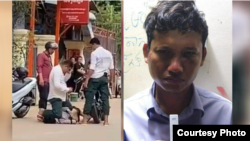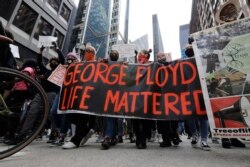A police arrest video from Phnom Penh, where an officer places his knee on the suspect’s neck, has drawn sharp criticism from some Cambodians, who are comparing it to the alleged murder of George Floyd by U.S. police officers.
The June 29 video shows the arrest of Vey Longreach, who police claim was an alleged drug trafficker in Phnom Penh’s Chbar Ampov district. The video, shot by a bystander, starts with one of the officers placing his knee on the back of Vey Longreach’s neck, despite having restrained the alleged drug offender’s arms.
The video also shows Vey Longreach being kicked by police officers as they attempt to take him away, while also pulling his hair and aggressively pushing him around.
The video, which is around 10 minutes, was posted to government mouthpiece Fresh News, with other shorter clips appearing on social media platforms Facebook and Tik Tok.
“Don’t hit me, I don’t know,” Vey Longreach says in the video. “I don’t have [drugs] with me.”
“[My] neck will break,” he is heard saying at one point, in between moans of pain.
The clip has drawn comparisons to a similar video filmed in the United States from May 25, where four police officers were caught on camera arresting Minneapolis resident George Floyd for suspected fraud.
That video, shot by a bystander, showed Minneapolis police officer Derek Chauvin placing his knee on George Floyd’s neck, while three of his colleagues pinned down the man. Floyd can be heard pleading with the officer to get off his neck because he couldn’t breathe, but Chauvin remains on his neck.
After nearly nine minutes of being unable to breathe, and amid cries for help, George Floyd died, sparking nationwide protests in the U.S. over police brutality towards the black community and people of color.
The protests, led by the ‘Black Lives Matter’ movement, also highlighted systemic racism faced by minority communities in the U.S., with mostly-peaceful protests, for racial equality and police reform, continuing five weeks after the death of George Floyd.
A Phnom Penh Municipal Police post on its website said police officials were attempting to arrest a group of people for alleged drug offenses when Vey Longreach attempted to escape on a motorcycle.
The police post claimed that Vey Longreach was “strongly addicted” and “completely drunk” during the arrest, and had “intention” to use violence against police officers.
While not acknowledging the police officers’ use of excessive force, the website admits that “unprofessional acts” were committed and that the police officers involved would be punished.
“We acknowledge that during the arrest operation, police worked beyond their professional obligations,” reads the post on the police website. “We will educate and punish [the officers] in accordance with police rules.”
Phnom Penh Police Chief Sar Theth said the suspect was an alleged drug trafficker and was getting violent with the police during the arrest.
The police chief added that Vey Longreach hit one of the police officers in the thigh, where the officer had an abscess, causing the police officer to retaliate.
“He fought back,” Sar Theth said, denying that the police officer placed a knee on Vey Longreach’s neck, despite the video clip showing otherwise.
“[Police] didn’t put pressure on the neck. [They] put pressure on the back,” he said. “The [people] just filmed it like that.”
When asked about comparisons to George Floyd’s death, Sar Theth said Cambodia was better than the U.S. because “the person did not die,” referring to Vey Longreach.
The video, posted on Fresh News, starts with a 50-second clip showing a district police officer placing his knee on Vey Longreach’s neck. Another officer is seen kicking Vey Longreach in the back, even though he is restrained and his hands tied together.
The video then cuts to a different angle where district police can be seen attempting to put Vey Longreach on a motorcycle, using a lot of force to lift him off the ground. A police officer, who can be seen wearing green khaki pants similar to police uniforms, pulls Vey Longreach’s hair and slaps him in the face.
After Vey Longreach falls back to the ground, the police attempt to get him on the motorcycle, again slapping him and twisting his arms. An elderly woman attempts to help Vey Longreach and take him away from the police, but VOA Khmer could not confirm her identity. At this point, the video ends.
The Fresh News article posted images of Vey Longreach with a bruised face, holding a drug test. Fresh News also posted a picture of a small packet, though there is no description of what is contained in the white packet.
The video gained traction among Cambodian Facebook users, who quickly compared it to George Floyd’s death. A screenshot of the video was posted by multiple Facebook users with angry comments criticizing the police for using excessive force.
“The [Cambodian police] have learned from the American police that by putting pressure with their knee on a Black American, killed him,” read one post from a Cambodian Facebook user.
Am Sam Ath, the deputy director for rights monitoring at Licadho, said the police had used violence by placing their knee on the man’s neck. He added that it was likely there were other cases of police excesses.
“I believe that there are possibly more cases,” he said. “We have to pay attention to what is captured on social media and take actions to make sure that it will not happen again.”
Chak Sopheap, the executive director at the Cambodian Center for Human Rights, said the photos and video were evidence of police brutality. She said police officers had used “excessive force” and performed an “inhuman act.”
“In Cambodia, this is not new. There are many stories related to excessive use of force,” she said. “Such abuse of power by police forces should be punished so that [others] won’t be encouraged [to do the same].”
The Phnom Penh arrest video comes a month after Prime Minister Hun Sen commented on George Floyd’s death and the ensuing protests, where U.S. media outlets reported police excesses in response to mostly-peaceful demonstrations.
At the time, Hun Sen asked Human Rights Watch’s Asia director, Brad Adams, if the rights group would comment on the rights violations in the U.S. because the U.S.-based group frequently criticized the Cambodian government.
Senior Cambodian government officials also posted pictures of U.S. protestors being met with police violence. Justice Ministry spokesperson Chin Malin on June 1 sarcastically asked in a Facebook post if “human rights groups will condemn the U.S.” for its actions against protestors.
In a separate post on June 7, Chin Malin said the U.S. cannot condemn the Cambodian government’s actions, along with a picture of law enforcement officials carrying away opposition leader Mu Sochua during a protest and other pictures from the violent crackdown of garment worker protests on Veng Sreng Boulevard from 2013 and 2014.
Speaking to VOA Khmer, Chin Malin on Thursday said people who were comparing the alleged drug arrest to that of George Floyd were “ill-intentioned” and that the two images were not the same.
“The picture from Cambodia is the same, but facts [of both arrests] are different,” he said, adding that the U.S. incident was based on racism, whereas Cambodian police officers were only attempting to arrest an alleged drug trafficker.
Chin Malin, who is also the deputy head of the Cambodian Human Rights Committee, did not comment on whether the police had used excessive force, saying it was hard to judge as an “outsider.”
“The police institutions will check whether it is the use of excessive force and if it is the abuse of the rights and freedoms of citizens or suspects,” he said.
Council of Minister's spokesperson Phay Siphan said the police had to use violence because the suspect was not complying with their instructions, putting the blame for police excesses on those suspected of committing a crime.
“If [suspects] cooperate and stand still, there will be no violence,” he said.








